Review: Closed-Cell Metallic Foams Produced via Powder Metallurgy
Abstract
1. Introduction
2. Background
2.1. Fundamentals of the Powder Compact Melt Foaming Process (PCMFP)
2.2. Common Blowing Agents Used in PCMFP
2.3. Production of the Bulk Foamable Precursor
2.4. Mechanisms of Bubble/Pore formation in PCMFP
3. Foaming of Metallic Foams and Their Composites
3.1. Foaming of Aluminum Alloys
3.1.1. Foaming Environment
3.1.2. Effect of Heating and Cooling Rates
3.2. The Foaming of Non-Aluminum Metals and Alloys
3.3. PCMFP of Aluminum-Composite Foams
4. Alternative Approaches
5. Conclusions
Author Contributions
Funding
Data Availability Statement
Acknowledgments
Conflicts of Interest
Appendix A
| Matrix | Blowing Agent | Wt.% | Comments | Precursor Relative Density | Bulk Density (g/cm3) | Expansion (%) | Reference |
|---|---|---|---|---|---|---|---|
| Al | CaCO3 | 10 | - | - | - | 14.8 | [105] |
| Al | CaCO3 | 15 | - | - | - | 52.0 | [105] |
| Al | CaCO3 | 20 | - | - | - | 53.0 | [105] |
| Al | TiH2 | 0.6 | - | - | - | 233.3 b | [152] |
| Al | TiH2 | 0.6 | - | >99% | - | 400 | [91] |
| Al | TiH2 | 0.6 | - | - | - | 350 | [115] |
| Al | TiH2 a | 0.6 | - | >99.4% | - | 162–254 | [26] |
| Al | TiH2 a | 0.6 | - | >99% | - | 350 | [91] |
| Al | TiH2 | 0.6 | Coarse Al, 0.536 wt% Oxygen | - | - | 440 | [153] |
| Al | TiH2 | 0.6 | Coarse Al, 0.061 wt% Oxygen | - | - | 170 | [153] |
| Al | TiH2 | 0.6 | Matrix preheated in air | >99% | - | 420 | [91] |
| Al | TiH2 | 1 | - | 95–96% | - | 164 | [110] |
| Al | TiH2 | 1 | - | >99.4% | 0.59–0.79 | - | [76] |
| Al | TiH2 | 1 | - | 98.6% | 0.59 | 300 | [45] |
| Al | TiH2 a | 1 | Ni-coated TiH2, 16.4 wt% of TiH2 | >99.4% | 0.60–0.76 | - | [76] |
| ADC12 | TiH2 | 1 | - | - | - | 400.00 b | [150] |
| Al 5083 | TiH2 | 1 | - | >99% | - | 88.68 b | [154] |
| Al 6061 | TiH2 | 0.6 | - | - | - | 320 c | [82] |
| Al 6061 | TiH2 | 0.8 | - | - | 0.59 | - | [155] |
| Al 6061 | TiH2 a | 0.8 | - | - | 0.62 | - | [155] |
| Al 6082 | TiH2 | 0.6 | - | - | 0.58 | - | [155] |
| Al 7020 | TiH2 | 0.6 | - | - | 0.58 | - | [155] |
| Al 7075 | TiH2 | 0.6 | - | - | 0.60 | - | [155] |
| AlMg0.6 | TiH2 | 0.6 | - | - | - | 472 | [107] |
| AlMg15Cu10 | AlMg50 (via adsorbed gases) | - | - | - | - | 248 | [57] |
| AlMg26Cu10 | AlMg50 (via adsorbed gases) | - | - | - | - | 311 | [57] |
| AlMg4.5Mn | CaMg (CO3)2 | 3 | Thixocasting | - | - | <100 | [156] |
| AlMg4Si6 | TiH2 a | 1 | - | - | - | 335–505 | [109] |
| AlMg4Si6Cu4 | TiH2 a | 1 | - | - | - | 275–380 | [109] |
| AlMg4Si8 | TiH2 a | 1 | - | - | - | 450–555 | [109] |
| AlMg6Si6 | TiH2 a | 1 | - | - | - | 285–365 | [109] |
| AlSi10.2 | TiH2 | 1.5 | N2 atmosphere | 95% | 0.505 | - | [87] |
| AlSi10Cu9Zn3 | TiH2 | 0.5 | - | 2.92 d | - | 475 | [113] |
| AlSi10Mg | TiH2 | 0.4 | 1000 mbar Ar atmosphere | - | 0.31–0.65 | - | [119] |
| AlSi10Mg | TiH2 | 0.4 | 2300 mbar Ar atmosphere | - | 0.48–0.75 | - | [119] |
| AlSi10Mg | TiH2 | 0.4 | 2800 mbar Ar atmosphere | - | 0.49–0.74 | - | [119] |
| AlSi11Cu4Zn2 | TiH2 | 0.5 | - | 2.79 d | - | 440 | [113] |
| AlSi12 | TiH2 | 1 | Matrix ball milled in air | 2.61–2.64 d | 0.93 | - | [118] |
| AlSi12.6Mg0.5 | TiH2 a | 0.5 | - | >98% | - | 244 | [69] |
| AlSi12Mg0.6Fe0.3 | TiH2 | 0.4 | - | >99.75% | 0.52 | - | [138] |
| AlSi4 | TiH2 a | NG | - | - | - | 420.8 b | [31] |
| AlSi6 | TiH2 a | 1 | - | - | - | 450–600 | [109] |
| AlSi6Cu2 | TiH2 a | 1 | - | - | - | 400–480 | [109] |
| AlSi6Cu4 | TiH2 a | 0.5 | - | - | - | 280 | [30] |
| AlSi6Cu4 | TiH2 a | 0.5 | - | >99% | - | 450 c | [22] |
| AlSi6Cu4 | TiH2 | 0.5 | 1 bar Ar atmosphere | - | - | 330 c | [93] |
| AlSi6Cu4 | TiH2 a | 1 | - | - | - | 430–510 | [109] |
| AlSi6Cu4 | TiH2 | 2.5 | 5 bar Ar atmosphere | - | - | 450 c | [93] |
| AlSi6Cu4 | TiH2 | 2.5 | 10 bar Ar atmosphere | - | - | 315 c | [93] |
| AlSi6Cu4 | TiH2 | 2.5 | 20 bar Ar atmosphere | - | - | 310 c | [93] |
| AlSi6Cu4 | TiH2 | 2.5 | 40 bar Ar atmosphere | - | - | 175 c | [93] |
| AlSi6Cu4 | ZrH2 | 0.5 | Precursor Preheat | >99% | - | 150 b | [27] |
| AlSi6Cu6 | TiH2 a | 1 | - | - | - | 400–450 | [109] |
| AlSi7 | TiH2 | 0.5 | - | - | 0.41–0.88 | - | [157] |
| AlSi7 | TiH2 | 0.5 | - | - | - | 436 | [68] |
| AlSi7 | TiH2 a | 0.5 | - | - | - | 371 | [68] |
| AlSi7 | TiH2 a | 0.5 | - | - | - | 420 | [30] |
| AlSi7 | TiH2 | 0.6 | - | - | - | 510 c | [82] |
| AlSi7Cu4 | TiH2 | 0.5 | Precursor Preheat | - | - | 128 | [95] |
| AlSi7Mg0.5 | TiH2 a | 0.5 | - | >98% | - | 316 | [69] |
| AlSi8Cu13Zn5 | TiH2 | 0.5 | - | 3.07 d | - | 420 | [113] |
| AlSi8Mg4 | KBH4 | 0.5 | - | - | - | 375 c | [56] |
| AlSi8Mg4 | LiAlH4 | 0.5 | - | - | - | 290 c | [56] |
| AlSi8Mg4 | LiBH4 | 0.5 | - | - | - | 320 c | [56] |
| AlSi8Mg4 | NaBH4 | 0.5 | - | - | - | 330 c | [56] |
| AlSi8Mg4 | TiH2 | 0.5 | - | - | - | 325 c | [56] |
| AlSi8Mg4 | TiH2 a | 1 | - | 97.20% | - | 888 | [88] |
| AlSi9 | TiH2 | 0.5 | - | 99.83% | - | 450 | [108] |
| AlSi9.6Mg1 | TiH2 | 0.8 | - | 98.90% | - | 240 c | [112] |
| AlSi9Cu2 | TiH2 | 0.5 | - | 99.96% | - | 544 | [108] |
| AlSi9Cu3 | CaCO3 | 3 | Thixocasting | - | - | 150 | [156] |
| AlSi9Cu3 | CaCO3 | 5 | Thixocasting | - | - | 200 | [156] |
| AlSi9Cu3 | CaMg(CO3)2 | 3 | Thixocasting | - | - | 266 | [156] |
| AlSi9Cu3 | CaMg(CO3)2 | 5 | Thixocasting | - | - | 282 | [156] |
| AlSi9Cu3 | TiH2 | 0.5 | - | - | - | 492 | [113] |
| AlSi9Cu3 | TiH2 a | 0.5 | - | - | - | 447 | [113] |
| AlSi9Cu4 | TiH2 | 0.5 | - | 99.90% | - | 585 | [108] |
| AlSi9Cu6 | TiH2 | 0.5 | - | 99.96% | - | 647 | [108] |
| AlSi9Mg0.5 | TiH2 a | 0.5 | - | >98% | - | 324 | [69] |
| AlSn1 | TiH2 | 1 | - | 98–99% | - | 484 | [110] |
| AlSn3 | TiH2 | 1 | - | 98–99% | - | 416 | [110] |
| AlSn5 | TiH2 | 1 | - | 95–96% | - | 391 | [110] |
| Au | TiH2 | 1 | - | 98.60% | - | Not Notable | [44] |
| AuAl2 | TiH2 | 1 | - | 100% | - | Not Notable | [44] |
| AuGe8 | TiH2 | 1 | - | 91% | - | 250 c | [44] |
| AuSi1 | TiH2 | 1 | - | 97.80% | - | 100 c | [44] |
| AuSi1.5 | TiH2 | 1 | - | 97.3–97.9% | - | 250 c | [44] |
| AuSi2 | MgH2 | 1 | - | 95% | - | 100 c | [44] |
| AuSi2 | TiH2 | 1 | - | 96.7–97.2% | - | 525 c | [44] |
| AuSi2 | ZrH2 | 1 | - | 95.90% | - | 475 c | [44] |
| AuSi2Cu4.5 | TiH2 | 1 | - | 93.70% | - | 425 c | [44] |
| AuSi3 | TiH2 | 1 | - | - | 375 c | [44] | |
| AuSn5 | TiH2 | 1 | - | 98.60% | - | Not Notable | [44] |
| FeC2.5 | MgCO3 | 0.2 | - | - | 143.90 b | [32] | |
| FeC2.5 | SrCO3 | 0.2 | - | - | 122.2 b | [32] | |
| Mg | CaCO3 | 5 | Precursor preheat and CO2+SF6 atmosphere | >99.5% | - | 170.3 b | [46] |
| Mg5Al5 | CaCO3 | 5 | Precursor preheat and CO2+SF6 atmosphere | 99.5–99.9% | - | 150 b | [131] |
| Mg80Al19Zn1 | CaCO3 | 5 | Precursor preheat and CO2+SF6 atmosphere | >99.5% | - | 354.6 b | [46] |
| Mg8Al2 | CaCO3 | 5 | Precursor preheat and CO2+SF6 atmosphere | 99.5–99.9% | - | 290.6 b | [131] |
| Pb | (PbCO3)2·Pb(OH)2 | 2 | - | >98.2% | 1.09 | 290 c | [39] |
| PbSb10 | (PbCO3)2·Pb(OH)2 | 2 | - | >96.6% | 1.59 | 275 c | [39] |
| PbSb10Sn10 | (PbCO3)2·Pb(OH)2 | 2 | - | >96.6% | 0.94 | 450 c | [39] |
| PbSb3 | (PbCO3)2·Pb(OH)2 | 2 | - | >96.6% | 1.3 | 275 c | [39] |
| PbSn10 | (PbCO3)2·Pb(OH)2 | 2 | - | >96.6% | 1 | 410 c | [39] |
| PbSn30 | (PbCO3)2·Pb(OH)2 | 2 | - | >96.6% | 1.06 | 480 c | [39] |
| PbSn5 | (PbCO3)2·Pb(OH)2 | 2 | - | >96.6% | 1.02 | 280 c | [39] |
| Zn | MgH2 | 0.16 | - | - | 393 | [64] | |
| Zn | TiH2 | 0.3 | - | >99.7% | - | 980 | [64] |
| Zn | TiH2 | 0.6 | - | - | 420 c | [23] | |
| Zn | ZrH2 | 0.56 | - | >99.7% | - | 699 | [64] |
| Zn-22Al | TiH2 | 1 | - | >99% | - | 194.1 b | [28] |
| ZnAl3.3Mg3.3 | AlMg50 (via adsorbed gases) | - | - | - | 332% | [57] | |
| ZnAl5.2Mg5.2 | AlMg50 (via adsorbed gases) | - | - | - | 483% | [57] | |
| ZnCu4 | ZrH2 | 0.4–0.8 | - | - | 1.04–1.95 | [112] |
| Matrix | Reinforcement | Wt.% | Blowing Agent | Wt% | Modifications | Precursor Relative Density | Expansion (%) | Reference |
|---|---|---|---|---|---|---|---|---|
| Al | Al2O3 | 3 vol% | TiH2 | 0.6 | - | >99% | 447 | [132] |
| Al | Al2O3 | 8 | TiH2 | 1 | - | >98% | 319–357 | [139] |
| AlCu7 | Al2O3 | 8 | TiH2 | 1 | - | 90–93% | 378–453 | [139] |
| AlMg1 | Al2O3 | 8 | TiH2 | 1 | - | >98% | 519–548 | [139] |
| AlSi11 | Al2O3 | 1 | TiH2 | 1 | Thixocasting | - | 332 | [86] |
| AlSi11 | Al2O3 | 3 | TiH2 | 1 | Thixocasting | - | 495 | [86] |
| AlSi11 | Al2O3 | 5 | TiH2 | 1 | Thixocasting | - | 676 | [86] |
| AlSi11.5 | Al2O3 | 8 | TiH2 | 1 | - | 90–93% | 342–437 | [139] |
| AlMg4.5Mn | CaO | 3 | CaCO3 | 5 | Thixocasting | - | <100 | [156] |
| AlMg4.5Mn | CaO | 3 | CaMg(CO3)2 | 5 | Thixocasting | - | <100 | [156] |
| AlSi9Cu3 | CaO | 3 | CaCO3 | 5 | Thixocasting | - | 208 | [156] |
| AlSi9Cu3 | CaO | 3 | CaMg(CO3)2 | 5 | Thixocasting | - | 296 | [156] |
| AlSi12Mg0.6Fe0.3 | Graphite | 3 vol% | TiH2 | 0.4 | - | >99.75% | 0.64 a | [138] |
| Al | SiC | 3 vol% | TiH2 | 0.6 | - | >99% | 435 | [132] |
| AlMg1 | SiC | 7 | TiH2 | 0.35 | - | 96.5% | 350 | [158] |
| AlMg1Sn3 | SiC | 7 | TiH2 | 0.35 | - | 96.5% | 430 | [158] |
| AlMg1Sn5 | SiC | 7 | TiH2 | 0.35 | - | 96.5% | 500 | [158] |
| AlSi11 | SiC | 1 | TiH2 | 1 | Thixocasting | - | 423 | [86] |
| AlSi11 | SiC | 3 | TiH2 | 1 | Thixocasting | - | 603 | [86] |
| AlSi11 | SiC | 5 | TiH2 | 1 | Thixocasting | - | 646 | [86] |
| AlSi12Mg0.6Fe0.3 | SiC | 3 vol% | TiH2 | 0.4 | - | >99.75% | 0.59 a | [138] |
| AlSi7 | SiC | 3 | TiH2 | 0.5 | - | - | 537 | [133] |
| AlSi7 | SiC | 6 | TiH2 | 0.5 | - | - | 388 | [133] |
| AlSi7 | SiC | 10 | TiH2 | 0.5 | - | - | 72 | [133] |
| Al | TiB2 | 3 vol% | TiH2 | 0.6 | - | >99% | 450 | [132] |
| AlSi7 | TiB2 | 0.05 | TiH2 | 0.5 | - | - | 520 | [159] |
References
- Ashby, M.F.; Evans, A.G.; Fleck, N.A.; Gibson, L.J.; Hutchinson, J.W.; Wadley, H.N.G. Metal Foams: A Design Guide Metal Foams: A Design Guide; Ashby, M.F., Evans, A.G., Hutchinson, J.W., Fleck, N.A., Eds.; Butterworth-Heinemann: Oxford, UK, 2000; Volume 54, ISBN 978-0-7506-3770-1. [Google Scholar]
- Rusakov, D.; Menner, A.; Bismarck, A. High-Performance Polymer Foams by Thermally Induced Phase Separation. Macromol. Rapid Commun. 2020, 41, 2000110. [Google Scholar] [CrossRef] [PubMed]
- Tomin, M.; Kmetty, Á. Polymer Foams as Advanced Energy Absorbing Materials for Sports Applications—A Review. J. Appl. Polym. Sci. 2022, 139, 51714. [Google Scholar] [CrossRef]
- Fey, T.; Betke, U.; Rannabauer, S.; Scheffler, M. Reticulated Replica Ceramic Foams: Processing, Functionalization, and Characterization. Adv. Eng. Mater. 2017, 19, 1700369. [Google Scholar] [CrossRef]
- Rocher, S.; Botrel, R.; Durut, F.; Chicanne, C.; Theobald, M.; Vignal, V. Ultra-Low Density Metallic Foams Synthesized by Contact Glow Discharge Electrolysis (CGDE) for Laser Experiments. EPJ Appl. Phys. 2018, 81, 10803. [Google Scholar] [CrossRef]
- Banhart, J. Manufacturing Routes for Metallic Foams. JOM 2000, 52, 22–27. [Google Scholar] [CrossRef]
- Ghaleh, M.H.; Ehsani, N.; Baharvandi, H.R. High-Porosity Closed-Cell Aluminum Foams Produced by Melting Method Without Stabilizer Particles. Int. J. Met. Cast. 2021, 15, 899–905. [Google Scholar] [CrossRef]
- Michailidis, N.; Stergioudi, F.; Omar, H.; Tsipas, D.N. Investigation of the Mechanical Behavior of Open-Cell Ni Foams by Experimental and FEM Procedures. Adv. Eng. Mater. 2008, 10, 112–1126. [Google Scholar] [CrossRef]
- Ho, P.H.; Jabłońska, M.; Palkovits, R.; Rodríguez-Castellón, E.; Ospitali, F.; Fornasari, G.; Vaccari, A.; Benito, P. N2O Catalytic Decomposition on Electrodeposited Rh-Based Open-Cell Metallic Foams. Chem. Eng. J. 2020, 379, 122259. [Google Scholar] [CrossRef]
- Liu, P.S.; Ma, X.M. Property Relations Based on the Octahedral Structure Model with Body-Centered Cubic Mode for Porous Metal Foams. Mater. Des. 2020, 188, 108413. [Google Scholar] [CrossRef]
- Davies, S.Z.G.J. Review Metallic Foams: Their Production, Properties and Applications. J. Mater. Sci. 1983, 18, 1899–1911. [Google Scholar] [CrossRef]
- Sunder Sharma, S.; Yadav, S.; Joshi, A.; Goyal, A.; Khatri, R. Application of Metallic Foam in Vehicle Structure: A Review. Mater. Today Proc. 2022, 63, 347–353. [Google Scholar] [CrossRef]
- Oriňaková, R.; Gorejová, R.; Králová, Z.O.; Petráková, M.; Oriňak, A. Novel Trends and Recent Progress on Preparation Methods of Biodegradable Metallic Foams for Biomedicine: A Review. J. Mater. Sci. 2021, 56, 13925–13963. [Google Scholar] [CrossRef]
- Tripathi, O.; Singh, D.P.; Dwivedi, V.K.; Agarwal, M. A Focused Review on Aluminum Metallic Foam: Processing, Properties, and Applications. Mater. Today Proc. 2020, 47, 6622–6627. [Google Scholar] [CrossRef]
- Utsunomiya, H.; Matsumoto, R. Deformation Processes of Porous Metals and Metallic Foams (Review). Procedia Mater. Sci. 2014, 4, 245–249. [Google Scholar] [CrossRef]
- Lefebvre, L.P.; Banhart, J.; Dunand, D.C. Porous Metals and Metallic Foams: Current Status and Recent Developments. Adv. Eng. Mater. 2008, 10, 775–787. [Google Scholar] [CrossRef]
- Banhart, J. Manufacture, Characterisation and Application of Cellular Metals and Metal Foams. Prog. Mater. Sci. 2001, 46, 559–632. [Google Scholar] [CrossRef]
- Atwater, M.A.; Guevara, L.N.; Darling, K.A.; Tschopp, M.A. Solid State Porous Metal Production: A Review of the Capabilities, Characteristics, and Challenges. Adv. Eng. Mater. 2018, 20, 1700766. [Google Scholar] [CrossRef]
- Liu, P.S.; Chen, G.F. Porous Materials: Processing and Applications; Butterworth-Heinemann: Oxford, UK, 2014; ISBN 978-0-12-407788-1. [Google Scholar]
- Morsi, K.; Krommehoek, M.; Shamma, M. Novel Aluminum Carbon Nanotube (AL-CNT) Open-Cell Foams. Metal. Mater. Trans. A 2016, 47, 2574–2576. [Google Scholar] [CrossRef]
- Krommenhoek, M.; Shamma, M.; Morsi, K. Processing, Characterization, and Properties of Aluminum–Carbon Nanotube Open-Cell Foams. J. Mater. Sci. 2017, 52, 3927–3935. [Google Scholar] [CrossRef]
- Matijasevic, B.; Banhart, J. Improvement of Aluminium Foam Technology by Tailoring of Blowing Agent. Scr. Mater. 2006, 54, 503–508. [Google Scholar] [CrossRef]
- Chethan, A.; Garcia-Moreno, F.; Wanderka, N.; Murty, B.S.; Banhart, J. Influence of Oxides on the Stability of Zinc Foam. J. Mater. Sci. 2011, 46, 7806–7814. [Google Scholar] [CrossRef]
- Banhart, J.; Stanzick, H.; Helfen, L.; Baumbach, T.; Nijhof, K. Real-Time X-Ray Investigation of Aluminum Foam Sandwich Production. Adv. Eng. Mater. 2001, 3, 407–411. [Google Scholar] [CrossRef]
- Durante, M.; Formisano, A.; Viscusi, A.; Carrino, L. An Innovative Manufacturing Method of Aluminum Foam Sandwiches Using a Mesh-Grid Reinforcement as Mold. Int. J. Adv. Manuf. Technol. 2020, 107, 3039–3048. [Google Scholar] [CrossRef]
- Kennedy, A.R. The Effect of TiH2 Heat Treatment on Gas Release and Foaming in Al–TiH2 Preforms. Scr. Mater. 2002, 47, 763–767. [Google Scholar] [CrossRef]
- Matijasevic, B.; Gorke, O.; Schubert, H.; Banhart, J. Zirconium Hydride-a Possible Blowing Agent for Making Aluminium Alloy Foams. In Porous Metals and Metal Foaming Technology; The Japan Institute of Metals: Tokyo, Japan, 2005; pp. 107–110. [Google Scholar]
- Kitazono, K.; Takiguchi, Y. Strain Rate Sensitivity and Energy Absorption of Zn-22Al Foams. Scr. Mater. 2006, 55, 501–504. [Google Scholar] [CrossRef]
- Karsu, N.D.; Yüksel, S.; Güden, M. Foaming Behavior of Ti6Al4V Particle-Added Aluminum Powder Compacts. J. Mater. Sci. 2009, 44, 1494–1505. [Google Scholar] [CrossRef]
- Mukherjee, M.; Garcia-Moreno, F.; Banhart, J. Defect Generation during Solidification of Aluminium Foams. Scr. Mater. 2010, 63, 235–238. [Google Scholar] [CrossRef]
- Yang, X.; Xie, M.; Li, W.; Sha, J.; Zhao, N. Controllable Design of Structural and Mechanical Behaviors of Al–Si Foams by Powder Metallurgy Foaming. Adv. Eng. Mater. 2022, 24, 2200125. [Google Scholar] [CrossRef]
- Park, C.; Nutt, S.R. PM Synthesis and Properties of Steel Foams. Mater. Sci. Eng. A 2000, 288, 111–118. [Google Scholar] [CrossRef]
- Shrivas, S.; Pandey, A.; Dubey, R.; Muhamad Shafeeq, M.; Gupta, G.; Mondal, D.P. Studies on Microstructure, Mechanical Properties, and Corrosion Behavior, of Partially Open-Cell Magnesium Foam through Powder Metallurgy Route. J. Mater. Eng. Perform. 2022, 31, 8840–8850. [Google Scholar] [CrossRef]
- Yaman, B.; Onuklu, E.; Korpe, N.O. The Usability of Boric Acid as an Alternative Foaming Agent on the Fabrication of Al/Al2O3 Composite Foams. J. Mater. Eng. Perform. 2017, 26, 2911–2914. [Google Scholar] [CrossRef]
- Saberi, Y.; Oveisi, H. High Porosity Micro- and Macro-Cellular Copper Foams with Semi-Open Cell Microstructure toward Its Physical and Mechanical Properties. Mater. Res. Express 2019, 7, 016549. [Google Scholar] [CrossRef]
- Allen, B.; Mote, M.; Sabroff, A. Method of Making Foamed Metal. U.S. Patent No. 3,087,807, 30 April 1963. [Google Scholar]
- Baumeister, J.; Schrader, H. Methods for Manufacturing Foamable Metal Bodies. US Patent 5,151,246, 29 September 1992. [Google Scholar]
- Baumeister, J. Porous Metal Body Prodn.—Involves Compaction at Low Temp. Followed by Heating to Near Melting Point of Metal. Patent DE19904018360, 29 May 1991. [Google Scholar]
- Irretier, A.; Banhart, J. Lead and Lead Alloy Foams. Acta Mater. 2005, 53, 4903–4917. [Google Scholar] [CrossRef]
- Kamm, P.H.; García-Moreno, F.; Neu, T.R.; Heim, K.; Mokso, R.; Banhart, J. Fast Synchrotron X-Ray Tomography of Dynamic Processes in Liquid Aluminium Alloy Foam: Fast Synchrotron X-Ray Tomography of Dynamic Processes. Adv. Eng. Mater. 2017, 19, 1600550. [Google Scholar] [CrossRef]
- García-Moreno, F.; Kamm, P.H.; Neu, T.R.; Bülk, F.; Mokso, R.; Schlepütz, C.M.; Stampanoni, M.; Banhart, J. Using X-ray Tomoscopy to Explore the Dynamics of Foaming Metal. Nat. Commun. 2019, 10, 3762. [Google Scholar] [CrossRef] [PubMed]
- Matijasevic-Lux, B.; Banhart, J.; Fiechter, S.; Görke, O.; Wanderka, N. Modification of Titanium Hydride for Improved Aluminium Foam Manufacture. Acta Mater. 2006, 54, 1887–1900. [Google Scholar] [CrossRef]
- Kamm, P.H.; Neu, T.R.; García-Moreno, F.; Banhart, J. Nucleation and Growth of Gas Bubbles in AlSi8Mg4 Foam Investigated by X-Ray Tomoscopy. Acta Mater. 2021, 206, 116583. [Google Scholar] [CrossRef]
- Banhart, J. Gold and Gold Alloy Foams. Gold Bull. 2008, 41, 251–256. [Google Scholar] [CrossRef]
- Proa-Flores, P.M.; Mendoza-Suarez, G.; Drew, R.A.L. Effect of TiH2 Particle Size Distribution on Aluminum Foaming Using the Powder Metallurgy Method. J. Mater. Sci. 2012, 47, 455–464. [Google Scholar] [CrossRef]
- Yang, D.; Guo, S.; Chen, J.; Qiu, C.; Agbedor, S.O.; Ma, A.; Jiang, J.; Wang, L. Preparation Principle and Compression Properties of Cellular Mg–Al–Zn Alloy Foams Fabricated by the Gas Release Reaction Powder Metallurgy Approach. J. Alloys Compd. 2021, 857, 158112. [Google Scholar] [CrossRef]
- Kennedy, A.R.; Asavavisitchai, S. Effects of TiB2 Particle Addition on the Expansion, Structure and Mechanical Properties of PM Al Foams. Scr. Mater. 2004, 50, 115–119. [Google Scholar] [CrossRef]
- Youn, S.W.; Kang, C.G. Fabrication of Foamable Precursors by Powder Compression and Induction Heating Process. Metall. Mater. Trans. B 2004, 35, 769–776. [Google Scholar] [CrossRef]
- Kathuria, Y.P. A Preliminary Study on Laser Assisted Aluminum Foaming. J. Mater. Sci. 2003, 38, 2875–2881. [Google Scholar] [CrossRef]
- Lehmhus, D.; Banhart, J. Properties of Heat-Treated Aluminium Foams. Mater. Sci. Eng. A 2003, 349, 98–110. [Google Scholar] [CrossRef]
- Šnajdar Musa, M.; Marić, G.; Grilec, K. Nanoindentation of Closed Cell Al Alloy Foams Subjected to Different Heat Treatment Regimes. Compos. Part B Eng. 2016, 89, 383–387. [Google Scholar] [CrossRef]
- Korpe, N.O.; Ozkan, E.; Tasci, U. Production of Aluminium–Fly Ash Particulate Composite by Powder Metallurgy Technique Using Boric Acid as Foaming Agent. Adv. Mater. Process. Technol. 2017, 3, 145–154. [Google Scholar] [CrossRef]
- Yaman, B.; Korpe, N.O.; Onuklu, E. Effect of Cubic Boron Nitride Addition on the Properties of Aluminium Composite Foams. Adv. Mater. Process. Technol. 2017, 3, 83–89. [Google Scholar] [CrossRef]
- Storage of Hydrogen. In Hydrogen and Energy; Palgrave Macmillan: London, UK, 1980; p. 65. ISBN 978-1-349-02635-7.
- Kováčik, J. Coloring of Pure Zinc Foams. METF 2017, 1, 54–59. [Google Scholar] [CrossRef]
- Kamm, P.H.; García-Moreno, F.; Jiménez, C.; Banhart, J. Suitability of Various Complex Hydrides for Foaming Aluminum Alloys. J. Mater. Res. 2013, 28, 2436–2443. [Google Scholar] [CrossRef]
- Mukherjee, M.; Garcia-Moreno, F.; Jiménez, C.; Banhart, J. Al and Zn Foams Blown by an Intrinsic Gas Source. Adv. Eng. Mater. 2010, 12, 472–477. [Google Scholar] [CrossRef]
- Koizumi, T.; Kido, K.; Kita, K.; Mikado, K.; Gnyloskurenko, S.; Nakamura, T. Foaming Agents for Powder Metallurgy Production of Aluminum Foam. Mater. Trans. 2011, 52, 728–733. [Google Scholar] [CrossRef]
- Yang, D.; Guo, S.; Chen, J.; Lu, J.; Wang, L.; Jiang, J.; Ma, A. Fabrication of Cu-Mg Alloy Foam with Close Pore Structure by Gas Release Reaction Powder Metallurgical Approach. J. Alloys Compd. 2018, 766, 851–858. [Google Scholar] [CrossRef]
- Cambronero, L.E.G.; Ruiz-Roman, J.M.; Corpas, F.A.; Ruiz Prieto, J.M. Manufacturing of Al–Mg–Si Alloy Foam Using Calcium Carbonate as Foaming Agent. J. Mater. Process. Technol. 2009, 209, 1803–1809. [Google Scholar] [CrossRef]
- Kevorkijan, V.; Škapin, S.D.; Paulin, I.; Šuštaršič, B.; Jenko, M. Synthesis and Characterisation of Closed Cells Aluminium Foams Containing Dolomite Powder as Foaming Agent. Mater. Technol. 2010, 44, 363–371. [Google Scholar]
- Papadopoulos, D.P.; Omar, H.; Stergioudi, F.; Tsipas, S.A.; Michailidis, N. The Use of Dolomite as Foaming Agent and Its Effect on the Microstructure of Aluminium Metal Foams—Comparison to Titanium Hydride. Colloids Surf. A Physicochem. Eng. Asp. 2011, 382, 118–123. [Google Scholar] [CrossRef]
- Sarig, S.; Kahana, F. Thermal Decomposition of Basic Lead Carbonate. Thermochim. Acta 1976, 14, 263–268. [Google Scholar] [CrossRef]
- von Zeppelin, F.; Hirscher, M.; Stanzick, H.; Banhart, J. Desorption of Hydrogen from Blowing Agents Used for Foaming Metals. Compos. Sci. Technol. 2003, 63, 2293–2300. [Google Scholar] [CrossRef]
- Soloki, A.; Esmailian, M. Carbonate-Foaming Agents in Aluminum Foams: Advantages and Perspectives. Metall. Mater. Trans. B Process Metall. Mater. Process. Sci. 2015, 46, 1052–1057. [Google Scholar] [CrossRef]
- Ibrahim, A.; Körner, C.; Singer, R.F. The Effect of TiH 2 Particle Size on the Morphology of Al-Foam Produced by PM Process. Adv. Eng. Mater. 2008, 10, 845–848. [Google Scholar] [CrossRef]
- Rasooli, A.; Boutorabi, M.A.; Divandari, M.; Azarniya, A. Effect of High Heating Rate on Thermal Decomposition Behaviour of Titanium Hydride (TiH2) Powder in Air. Bull Mater. Sci. 2013, 36, 301–309. [Google Scholar] [CrossRef]
- Lehmhus, D.; Rausch, G. Tailoring Titanium Hydride Decomposition Kinetics by Annealing in Various Atmospheres. Adv. Eng. Mater. 2004, 6, 313–330. [Google Scholar] [CrossRef]
- Muduli, B.; Ramesh, T.; Hari Kumar, K.C.; Rajalakshmi, N.; Mukherjee, M. Customised Heat Treatment of TiH2 for the Foaming of Aluminium Alloys. Materialia 2019, 8, 100431. [Google Scholar] [CrossRef]
- Morsi, K.; Daoush, W.M. Al-TiH2 Composite “particles” as Foaming Precursors for Metallic Foams. Scr. Mater. 2015, 105, 6–9. [Google Scholar] [CrossRef]
- Cheng, Y.; Li, Y.; Chen, X.; Shi, T.; Liu, Z.; Wang, N. Fabrication of Aluminum Foams with Small Pore Size by Melt Foaming Method. Metall. Mater. Trans. B 2017, 48, 754–762. [Google Scholar] [CrossRef]
- An, Y.; Ma, H.; Zhang, J.; Zhang, P.; Zhao, E.; Yang, S. Foaming Stabilization and Mechanical Properties of High-Toughness Aluminum Foam Fabricated Using Non-Thickening Foaming Technology. J. Mater. Process. Technol. 2021, 296, 117212. [Google Scholar] [CrossRef]
- Ding, X.; Liu, Y.; Chen, X.; Zhang, H.; Li, Y. Optimization of Cellular Structure of Aluminum Foams Produced by Powder Metallurgy Method. Mater. Lett. 2018, 216, 38–41. [Google Scholar] [CrossRef]
- Zhou, X.; Li, Y.; Chen, X. Development of AlMg35-TiH2 Composite Foaming Agent and Fabrication of Small Pore Size Aluminium Foams. J. Mater. Process. Technol. 2020, 283, 116698. [Google Scholar] [CrossRef]
- Azarniya, A.; Rasooli, A. High-Temperature Mechanisms of Hydrogen Evolution in Ni–P Coated Titanium Hydride (TiH 2) Powder. Adv. Powder Technol. 2016, 27, 281–288. [Google Scholar] [CrossRef]
- Proa-Flores, P.M.; Drew, R.A.L. Production of Aluminum Foams with Ni-Coated TiH 2 Powder. Adv. Eng. Mater. 2008, 10, 830–834. [Google Scholar] [CrossRef]
- Fang, J.; Ding, B.; Yang, Z.; Zhao, K.; Gu, C. The Effect of SiO2 and Al2O3 Coating on the Surface of TiH2 Powders on Gas Release. J. Colloid Interface Sci. 2005, 283, 1–4. [Google Scholar] [CrossRef]
- Li, X.; Liu, Y.; Ye, J.; An, X.; Cao, Z.; Liu, X. Innovative Surface Modification of TiH2 to Fabricate Aluminum Foam with Enhanced Mechanical Properties. Mater. Lett. 2018, 210, 350–353. [Google Scholar] [CrossRef]
- Lu, G.; Hao, H.; Wang, F.; Zhang, X. Preparation of Closed-Cell Mg Foams Using SiO2-Coated CaCO3 as Blowing Agent in Atmosphere. Trans. Nonferrous Met. Soc. China 2013, 23, 1832–1837. [Google Scholar] [CrossRef]
- Nakamura, T.; Gnyloskurenko, S.; Sakamoto, K.; Byakova, A.; Ishikawa, R. Development of New Foaming Agent for Metal Foam. Mater. Trans. 2002, 43, 1191–1196. [Google Scholar] [CrossRef]
- Ji, H.-B.; Zu, G.; Yao, G.-C.; Liu, L.-T. On the Silica-Coated Surface of Magnesium Carbonate Particles. Dongbei Daxue Xuebao/J. Northeast. Univ. 2009, 30, 701–703+707. [Google Scholar]
- Duarte, I.; Banhart, J. A Study of Aluminium Foam Formation—Kinetics and Microstructure. Acta Mater. 2000, 48, 2349–2362. [Google Scholar] [CrossRef]
- German, R.M. Powder Metallurgy & Particulate Materials Processing; Metal Powder Industry Federation: Princeton, NJ, USA, 2005. [Google Scholar]
- Bonaccorsi, L.; Proverbio, E. Powder Compaction Effect on Foaming Behavior of Uni-Axial Pressed PM Precursors. Adv. Eng. Mater. 2006, 8, 864–869. [Google Scholar] [CrossRef]
- Linul, E.; Pietras, D.; Sadowski, T.; Marşavina, L.; Rajak, D.K.; Kovacik, J. Crashworthiness Performance of Lightweight Composite Metallic Foams at High Temperatures. Compos. Part A Appl. Sci. Manuf. 2021, 149, 106516. [Google Scholar] [CrossRef]
- Haesche, M.; Weise, J.; Garcia-Moreno, F.; Banhart, J. Influence of Particle Additions on the Foaming Behaviour of AlSi11/TiH2 Composites Made by Semi-Solid Processing. Mater. Sci. Eng. A 2008, 480, 283–288. [Google Scholar] [CrossRef]
- Feng, Y.; Zheng, H.; Zhu, Z.; Zu, F. The Microstructure and Electrical Conductivity of Aluminum Alloy Foams. Mater. Chem. Phys. 2003, 78, 196–201. [Google Scholar] [CrossRef]
- Helwig, H.-M.; Hiller, S.; Garcia-Moreno, F.; Banhart, J. Influence of Compaction Conditions on the Foamability of AlSi8Mg4 Alloy. Metall. Mater. Trans. B 2009, 40, 755–767. [Google Scholar] [CrossRef]
- Kennedy, A.R. Effect of Compaction Density on Foamability of Al-TiH2 Powder Compacts. Powder Metall. 2002, 45, 75–79. [Google Scholar] [CrossRef]
- Lázaro, J.; Solórzano, E.; De Saja, J.A.; Rodríguez-Pérez, M.A. Early Anisotropic Expansion of Aluminium Foam Precursors. J. Mater. Sci. 2013, 48, 5036–5046. [Google Scholar] [CrossRef]
- Asavavisithchai, S.; Kennedy, A.R. The Role of Oxidation during Compaction on the Expansion and Stability of Al Foams Made via a PM Route. Adv. Eng. Mater. 2006, 8, 568–572. [Google Scholar] [CrossRef]
- Jiménez, C.; Garcia-Moreno, F.; Mukherjee, M.; Goerke, O.; Banhart, J. Improvement of Aluminium Foaming by Powder Consolidation under Vacuum. Scr. Mater. 2009, 61, 552–555. [Google Scholar] [CrossRef]
- García-Moreno, F.; Banhart, J. Influence of Gas Pressure and Blowing Agent Content on the Formation of Aluminum Alloy Foam. Adv. Eng. Mater. 2021, 23, 2100242. [Google Scholar] [CrossRef]
- Lázaro, J.; Solórzano, E.; Rodríguez-Pérez, M.A.; Rämer, O.; García-Moreno, F.; Banhart, J. Heat Treatment of Aluminium Foam Precursors: Effects on Foam Expansion and Final Cellular Structure. Procedia Mater. Sci. 2014, 4, 287–292. [Google Scholar] [CrossRef]
- Deng, F.; Liu, Y.; Lu, X.; Fan, J. Improved Stability of Aluminum Foam Through Heat Treatment of Foamable Precursor. Met. Mater. Int. 2020, 26, 1596–1601. [Google Scholar] [CrossRef]
- Zhang, R.; Geng, D.; Yan, D.; Li, H.; Zu, G. Stabilization of Closed-Cell Aluminum Foams by Horizontal Steady Magnetic Field: Numerical Simulation on Drainage for Node-Plateau Borders Systems. Jmrt 2022, 20, 320–329. [Google Scholar] [CrossRef]
- Moreno, F.G.; Fromme, M.; Banhart, J. Real-Time X-Ray Radioscopy on Metallic Foams Using a Compact Micro-Focus Source. Adv. Eng. Mater. 2004, 6, 416–420. [Google Scholar] [CrossRef]
- García-Moreno, F.; Tobin, S.T.; Mukherjee, M.; Jiménez, C.; Solórzano, E.; Vinod Kumar, G.S.; Hutzler, S.; Banhart, J. Analysis of Liquid Metal Foams through X-Ray Radioscopy and Microgravity Experiments. Soft Matter 2014, 10, 6955–6962. [Google Scholar] [CrossRef]
- García-Moreno, F.; Kamm, P.H.; Neu, T.R.; Bülk, F.; Noack, M.A.; Wegener, M.; von der Eltz, N.; Schlepütz, C.M.; Stampanoni, M.; Banhart, J. Tomoscopy: Time-Resolved Tomography for Dynamic Processes in Materials. Adv. Mater. 2021, 33, 2104659. [Google Scholar] [CrossRef] [PubMed]
- Rack, A.; Helwig, H.M.; Bütow, A.; Rueda, A.; Matijašević-Lux, B.; Helfen, L.; Goebbels, J.; Banhart, J. Early Pore Formation in Aluminium Foams Studied by Synchrotron-Based Microtomography and 3-D Image Analysis. Acta Mater. 2009, 57, 4809–4821. [Google Scholar] [CrossRef]
- Helfen, L.; Baumbach, T.; Stanzick, H.; Banhart, J.; Elmoutaouakkil, A.; Cloetens, P. Viewing the Early Stage of Metal Foam Formation by Computed Tomography Using Synchrotron Radiation. Adv. Eng. Mater. 2002, 4, 808. [Google Scholar] [CrossRef]
- Helfen, L.; Baumbach, T.; Pernot, P.; Cloetens, P.; Stanzick, H.; Schladitz, K.; Banhart, J. Investigation of Pore Initiation in Metal Foams by Synchrotron-Radiation Tomography. Appl. Phys. Lett. 2005, 86, 231907. [Google Scholar] [CrossRef]
- García-Moreno, F.; Jürgens, M.; Banhart, J. Temperature Dependence of Film Rupture and Internal Structural Stability in Liquid Aluminium Alloy Foams. Acta Mater. 2020, 196, 325–337. [Google Scholar] [CrossRef]
- Mukherjee, M.; García-Moreno, F.; Jiménez, C.; Rack, A.; Banhart, J. Microporosity in Aluminium Foams. Acta Mater. 2017, 131, 156–168. [Google Scholar] [CrossRef]
- Gersamipour, T.; Oveisi, H. Effects of Foaming Parameters on Microstructure and Compressive Properties of Aluminum Foams Produced by Powder Metallurgy Method. Trans. Nonferrous Met. Soc. China 2017, 27, 1569–1579. [Google Scholar] [CrossRef]
- Wang, L.; Hua, Z.S.; Ma, J.; Yao, G.C. Effects of Mg Addition on Foam Stability of Al Foams Made by Powder Metallurgy Route. Powder Metall. 2011, 54, 385–388. [Google Scholar] [CrossRef]
- Wang, L.; Yao, G.C.; Luo, H.J.; Liang, L.S.; Zhang, Z.G. Effect of Addition of Mg Powders on Foaming Behaviors of Al Foams. Zhongguo Youse Jinshu Xuebao/Chin. J. Nonferrous Met. 2010, 20, 1339–1345. [Google Scholar]
- Deng, F.; Fan, J.; Liu, Y.; Lu, X.; Wei, S.; Nie, J. Effect of Cu on Pore Structure of Al–Si Foam. Met. Mater. Int. 2021, 27, 5239–5246. [Google Scholar] [CrossRef]
- Helwig, H.-M.; Garcia-Moreno, F.; Banhart, J. A Study of Mg and Cu Additions on the Foaming Behaviour of Al–Si Alloys. J Mater. Sci. 2011, 46, 5227–5236. [Google Scholar] [CrossRef]
- Aguirre-Perales, L.Y.; Jung, I.-H.; Drew, R.A.L. Foaming Behavior of Powder Metallurgical Al–Sn Foams. Acta Mater. 2012, 60, 759–769. [Google Scholar] [CrossRef]
- Uzun, A. Production of Aluminium Foams Reinforced with Silicon Carbide and Carbon Nanotubes Prepared by Powder Metallurgy Method. Compos. Part B Eng. 2019, 172, 206–217. [Google Scholar] [CrossRef]
- Lázaro, J.; Laguna-Gutiérrez, E.; Solórzano, E.; Rodríguez-Pérez, M.A. Effect of Microstructural Anisotropy of PM Precursors on the Characteristic Expansion of Aluminum Foams. Metall. Mater. Trans. B Process Metall. Mater. Process. Sci. 2013, 44, 984–991. [Google Scholar] [CrossRef]
- Lehmhus, D.; Busse, M. Potential New Matrix Alloys for Production of PM Aluminium Foams. Adv. Eng. Mater. 2004, 6, 391–396. [Google Scholar] [CrossRef]
- García-Moreno, F.; Radtke, L.A.; Neu, T.R.; Kamm, P.H.; Klaus, M.; Schlepütz, C.M.; Banhart, J. The Influence of Alloy Composition and Liquid Phase on Foaming of Al–Si–Mg Alloys. Metals 2020, 10, 189. [Google Scholar] [CrossRef]
- Asavavisithchai, S.; Kennedy, A.R. In-Situ Oxide Stabilization Development of Aluminum Foams in Powder Metallurgical Route. High Temp. Mater. Process. 2011, 30, 113–120. [Google Scholar] [CrossRef]
- Körner, C.; Arnold, M.; Singer, R.F. Metal Foam Stabilization by Oxide Network Particles. Mater. Sci. Eng. A 2005, 396, 28–40. [Google Scholar] [CrossRef]
- Dudka, A.; Garcia-Moreno, F.; Wanderka, N.; Banhart, J. Structure and Distribution of Oxides in Aluminium Foam. Acta Mater. 2008, 56, 3990–4001. [Google Scholar] [CrossRef]
- Prosviryakov, A.S.; Solonin, A.N.; Churyumov, A.Y.; Mantesevich, N.M.; Kolerov, L.V. On the Effect of Oxidative Milling of Matrix Powder on the Structure and Properties of Aluminum Foam Based on the Al-Si Alloy. Phys. Met. Metallogr. 2022, 123, 491–498. [Google Scholar] [CrossRef]
- Körner, C.; Berger, F.; Arnold, M.; Stadelmann, C.; Singer, R.F. Influence of Processing Conditions on Morphology of Metal Foams Produced from Metal Powder. Mater. Sci. Technol. 2000, 16, 781–784. [Google Scholar] [CrossRef]
- Costanza, G.; Gusmano, G.; Montanari, R.; Tata, M.E.; Ucciardello, N. Effect of Powder Mix Composition on Al Foam Morphology. Proc. Inst. Mech. Eng. Part L J. Mater. Des. Appl. 2008, 222, 131–140. [Google Scholar] [CrossRef]
- Sahu, S.N.; Gokhale, A.A.; Mehra, A. Prediction of Bubble Size Distribution in Aluminium Foam as a Function of %Titanium Hydride Addition. Trans. Indian Inst. Met. 2017, 70, 1981–1994. [Google Scholar] [CrossRef]
- García-Moreno, F.; Mukherjee, M.; Solórzano, E.; Banhart, J. Metal Foams—Towards Microcellular Materials: Dedicated to Prof. Dr. H.-P. Degischer on the Occasion of His 65th Birthday. Int. J. Mater. Res. 2010, 101, 1134–1139. [Google Scholar] [CrossRef]
- Neu, T.; Pfretzschner, B.; García-Moreno, F.; Banhart, J. Influence of the Heating Rate on the Foaming Behavior of Various Aluminium Alloys. Metals 2017, 7, 323. [Google Scholar] [CrossRef]
- Kobashi, M.; Tanahashi, S.; Kanetake, N. Foaming Behavior of Porous Aluminum by Heating of Precursors of Al-TiH2 Powder. J. Jpn. Inst. Light Met. 2003, 53, 427–432. [Google Scholar] [CrossRef]
- Youn, S.W.; Kang, C.G. The Effect of Process Parameters on Cell Morphology in Cellular Aluminium Alloy Fabricated by Powder Compression and the Induction Heating Process. Proc. Inst. Mech. Eng. Part B J. Eng. Manuf. 2003, 217, 201–211. [Google Scholar] [CrossRef]
- Mukherjee, M.; Ramamurty, U.; Garcia-Moreno, F.; Banhart, J. The Effect of Cooling Rate on the Structure and Properties of Closed-Cell Aluminium Foams. Acta Mater. 2010, 58, 5031–5042. [Google Scholar] [CrossRef]
- Brunke, O.; Hamann, A.; Cox, S.J.; Odenbach, S. Experimental and Numerical Analysis of the Drainage of Aluminium Foams. J. Phys. Condens. Matter 2005, 17, 6353–6362. [Google Scholar] [CrossRef]
- Han, B.; Li, Y.; Wang, Z.; Gu, X.; Zhang, Q. Temperature Effects on the Compressive Behaviors of Closed-Cell Copper Foams Prepared by Powder Metallurgy. Materials 2021, 14, 6405. [Google Scholar] [CrossRef]
- Wang, H.; Zhu, D.F.; Wu, Y.; Liu, X.J.; Jiang, S.H.; Nieh, T.G.; Lu, Z.P. New Insight into Fabrication of Shaped Mg–X Alloy Foams with Cellular Structure via a Gas Release Reaction Powder Metallurgy Route. J. Iron Steel Res. Int. 2021, 28, 125–132. [Google Scholar] [CrossRef]
- Yang, D.; Chen, J.; Chen, W.; Wang, L.; Wang, H.; Jiang, J.; Ma, A. Fabrication of Cellular Zn–Mg Alloy Foam by Gas Release Reaction via Powder Metallurgical Approach. J. Mater. Sci. Technol. 2017, 33, 1141–1146. [Google Scholar] [CrossRef]
- Yang, D.; Hu, Z.; Chen, W.; Lu, J.; Chen, J.; Wang, H.; Wang, L.; Jiang, J.; Ma, A. Fabrication of Mg-Al Alloy Foam with Close-Cell Structure by Powder Metallurgy Approach and Its Mechanical Properties. J. Manuf. Process. 2016, 22, 290–296. [Google Scholar] [CrossRef]
- Kennedy, A.R.; Asavavisithchai, S. Effect of Ceramic Particle Additions on Foam Expansion and Stability in Compacted Al-TiH2 Powder Precursors. Adv. Eng. Mater. 2004, 6, 400–402. [Google Scholar] [CrossRef]
- Esmaeelzadeh, S.; Simchi, A.; Lehmhus, D. Effect of Ceramic Particle Addition on the Foaming Behavior, Cell Structure and Mechanical Properties of P/M AlSi7 Foam. Mater. Sci. Eng. A 2006, 424, 290–299. [Google Scholar] [CrossRef]
- Hailat, M.M. Effect of Silicon Carbide and Titanium Hydride on the Foamability of Aluminum Alloy (6061). J. Mater. Sci. Chem. Eng. 2017, 5, 1–11. [Google Scholar] [CrossRef]
- Guden, M.; Yüksel, S. SiC-Particulate Aluminum Composite Foams Produced from Powder Compacts: Foaming and Compression Behavior. J. Mater. Sci. 2006, 41, 4075–4084. [Google Scholar] [CrossRef]
- Du, Y.; Li, A.B.; Zhang, X.X.; Tan, Z.B.; Su, R.Z.; Pu, F.; Geng, L. Enhancement of the Mechanical Strength of Aluminum Foams by SiC Nanoparticles. Mater. Lett. 2015, 148, 79–81. [Google Scholar] [CrossRef]
- Mahmutyazicioglu, N.; Albayrak, O.; Ipekoglu, M.; Altintas, S. Effects of Alumina (Al2O3) Addition on the Cell Structure and Mechanical Properties of 6061 Foams. J. Mater. Res. 2013, 28, 2509–2519. [Google Scholar] [CrossRef]
- Kováčik, J.; Nosko, M.; Mináriková, N.; Simančík, F.; Jerz, J. Closed-Cell Powder Metallurgical Aluminium Foams Reinforced with 3 Vol.% Sic and 3 Vol.% Graphite. Processes 2021, 9, 2031. [Google Scholar] [CrossRef]
- Klinter, A.J.; Leon, C.A.; Drew, R.A.L. The Optimum Contact Angle Range for Metal Foam Stabilization: An Experimental Comparison with the Theory. J. Mater. Sci. 2010, 45, 2174–2180. [Google Scholar] [CrossRef]
- Oveisi, H.; Geramipour, T. High Mechanical Performance Alumina-Reinforced Aluminum Nanocomposite Metal Foam Produced by Powder Metallurgy: Fabrication, Microstructure Characterization, and Mechanical Properties. Mater. Res. Express 2019, 6, 1250c2. [Google Scholar] [CrossRef]
- Damanik, F.S.; Lange, G. Influence of MWCNT Coated Nickel on the Foaming Behavior of Mwcnt Coated Nickel Reinforced Almg4si8 Foam by Powder Metallurgy Process. Metals 2020, 10, 955. [Google Scholar] [CrossRef]
- Duarte, I.; Ventura, E.; Olhero, S.; Ferreira, J.M.F. An Effective Approach to Reinforced Closed-Cell Al-Alloy Foams with Multiwalled Carbon Nanotubes. Carbon 2015, 95, 589–600. [Google Scholar] [CrossRef]
- Duarte, I.; Ventura, E.; Olhero, S.; Ferreira, J.M. A Novel Approach to Prepare Aluminium-Alloy Foams Reinforced by Carbon-Nanotubes. Mater. Lett. 2015, 160, 162–166. [Google Scholar] [CrossRef]
- Li, W.; Yang, X.; Yang, K.; He, C.; Sha, J.; Shi, C.; Mei, Y.; Li, J.; Zhao, N. Simultaneously Optimizing Pore Morphology and Enhancing Mechanical Properties of Al-Si Alloy Composite Foams by Graphene Nanosheets. J. Mater. Sci. Technol. 2022, 101, 60–70. [Google Scholar] [CrossRef]
- Suryanarayana, C. Mechanical Alloying and Milling. Prog. Mater. Sci. 2001, 46, 1–184. [Google Scholar] [CrossRef]
- Key, D.; Daoush, W.M.; Morsi, K. Processing of Microscale Aluminum Foamed Particles. Mater. Perform. Charact. 2020, 9, 442–451. [Google Scholar] [CrossRef]
- Kathuria, Y.P. Aluminium Foaming Using a CO2 Laser. Mater. Sci. Technol. 2001, 17, 593–596. [Google Scholar] [CrossRef]
- Campana, G.; Ascari, A.; Fortunato, A. Laser Foaming for Joining Aluminum Foam Cores inside a Hollow Profile. Opt. Laser Technol. 2013, 48, 331–336. [Google Scholar] [CrossRef]
- Zhao, Y.; Ma, C.; Xin, D.; Sun, M. Dynamic Mechanical Properties of Closed-Cell Aluminum Foams with Uniform and Graded Densities. J. Mater. Res. 2020, 35, 2575–2586. [Google Scholar] [CrossRef]
- Suzuki, R.; Sakurai, Y.; Matsubara, M. Bonding Process between Aluminum Foams Using Foaming of Low Melting Point Precursor. J. Jpn. Inst. Met. 2015, 80, 134–139. [Google Scholar] [CrossRef]
- Hangai, Y.; Ando, M.; Ohashi, M.; Amagai, K.; Suzuki, R.; Matsubara, M.; Yoshikawa, N. Compressive Properties of Two-Layered Aluminum Foams with Closed-Cell and Open-Cell Structures. Mater. Today Commun. 2020, 24, 101249. [Google Scholar] [CrossRef]
- Papantoniou, I.; Kyriakopoulou, H.P.; Pantelis, D.I.; Manolakos, D.E. Metal Foaming by Powder Metallurgy Process: Investigation of Different Parameters on the Foaming Efficiency. Frat. Ed Integrita Strutt. 2019, 13, 497–504. [Google Scholar] [CrossRef]
- Asavavisithchai, S.; Kennedy, A.R. The Effect of Oxides in Various Aluminium Powders on Foamability. Procedia Eng. 2012, 32, 714–721. [Google Scholar] [CrossRef]
- Suzuki, R.; Kitazono, K. Quantitative Evaluation of the Anisotropic Foaming Behavior for Aluminum Foams. J. Jpn. Inst. Met. 2010, 74, 314–320. [Google Scholar] [CrossRef]
- Lehmhus, D.; Banhart, J.; Rodriguez-Perez, M.A. Adaptation of Aluminium Foam Properties by Means of Precipitation Hardening. Mater. Sci. Technol. 2002, 18, 474. [Google Scholar] [CrossRef]
- Haesche, M.; Lehmhus, D.; Weise, J.; Wichmann, M.; Mocellin, I.C.M. Carbonates as Foaming Agent in Chip-Based Aluminium Foam Precursor. J. Mater. Sci. Technol. 2010, 26, 845–850. [Google Scholar] [CrossRef]
- Duarte, I.; Krstulović-Opara, L.; Vesenjak, M. Analysis of Performance of In-Situ Carbon Steel Bar Reinforced Al-Alloy Foams. Compos. Struct. 2016, 152, 432–443. [Google Scholar] [CrossRef]
- Lin, H.; Luo, H.; Zhang, Z.; Ma, J.; Yao, G. Study on Improvement of Aluminum Foams by Rapid Foaming. Mater. Lett. 2017, 188, 288–290. [Google Scholar] [CrossRef]
- Lehmhus, D.; Hünert, D.; Mosler, U.; Martin, U.; Weise, J. Effects of Eutectic Modification and Grain Refinement on Microstructure and Properties of PM AlSi7 Metallic Foams. Metals 2019, 9, 1241. [Google Scholar] [CrossRef]
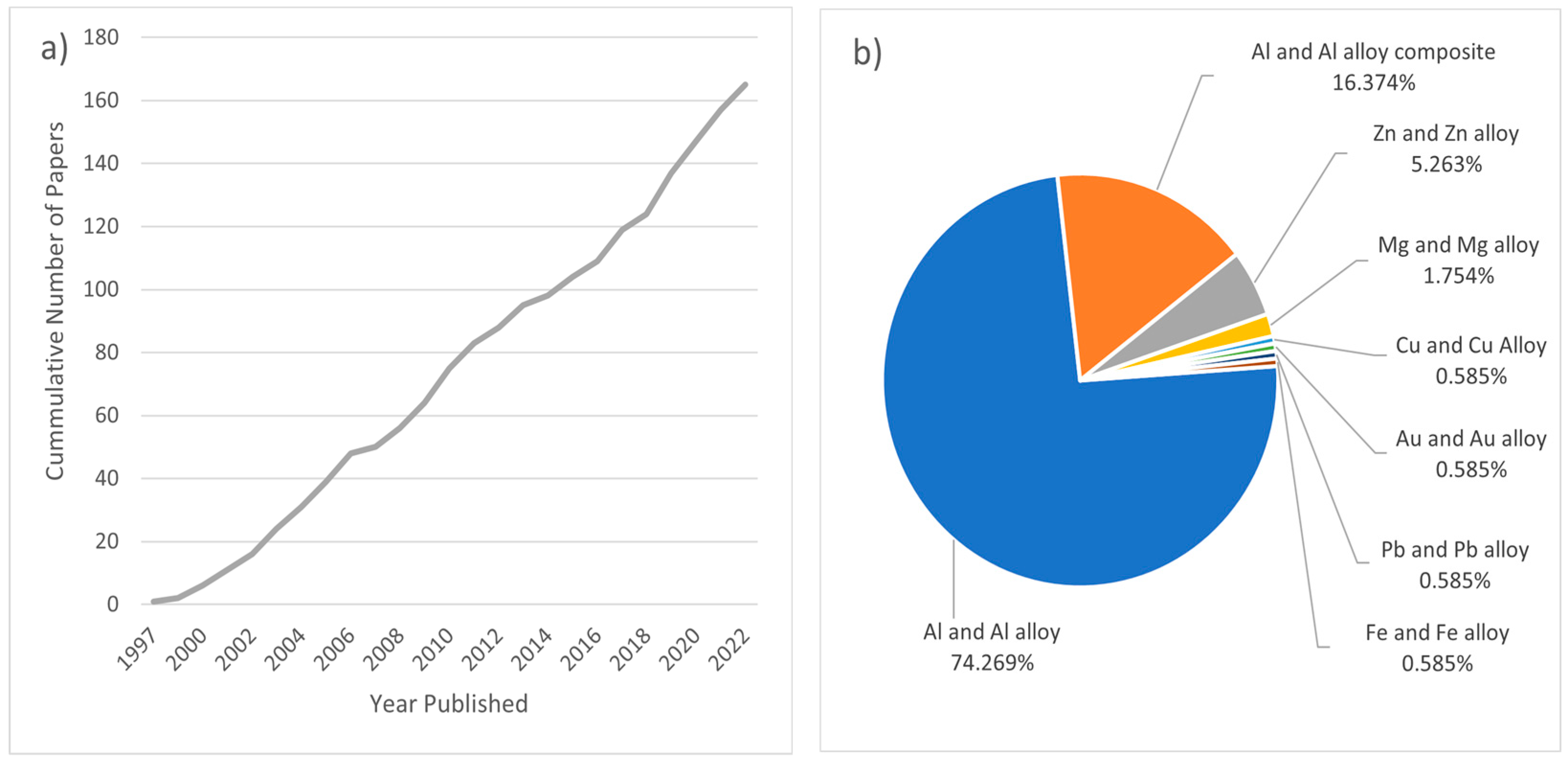
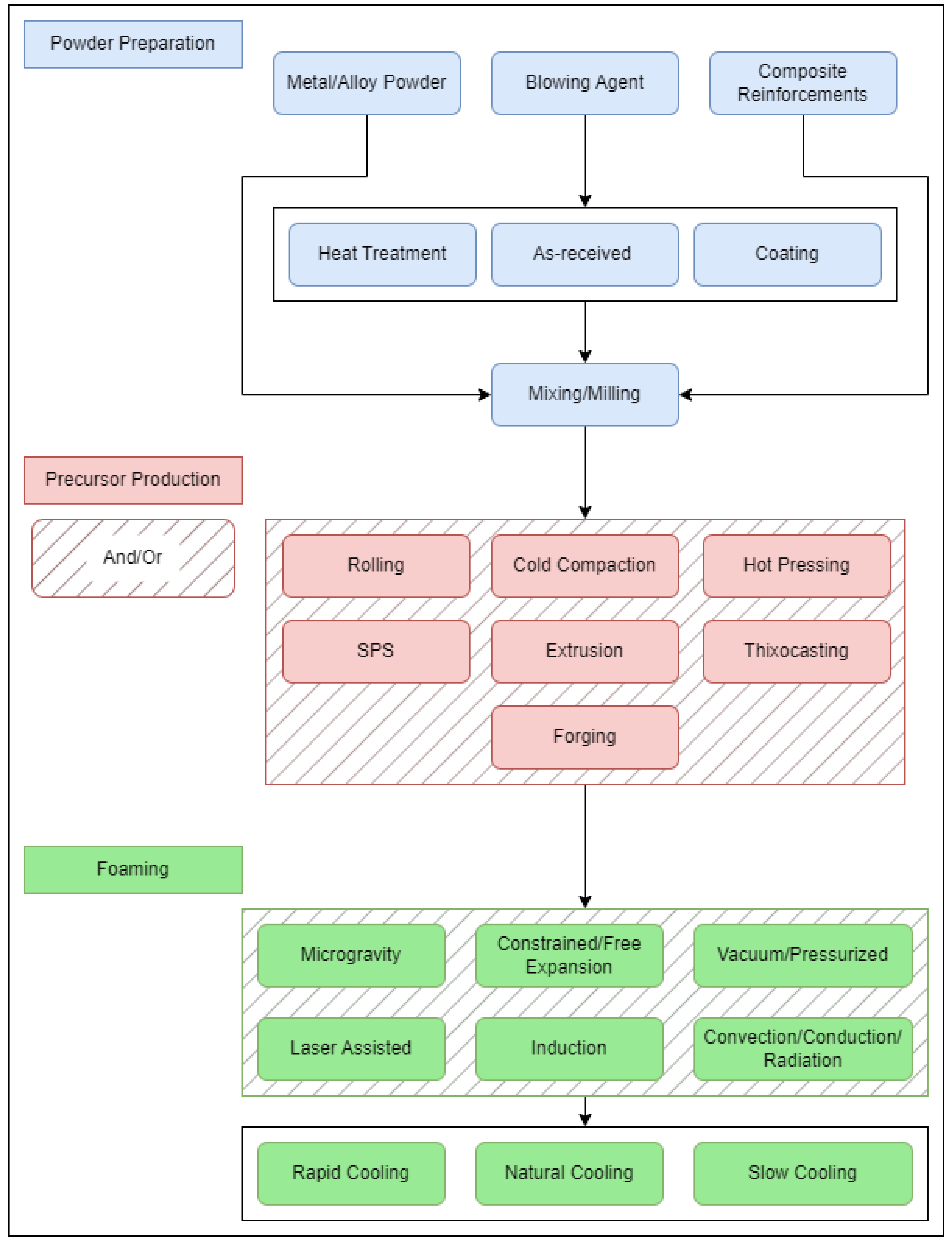
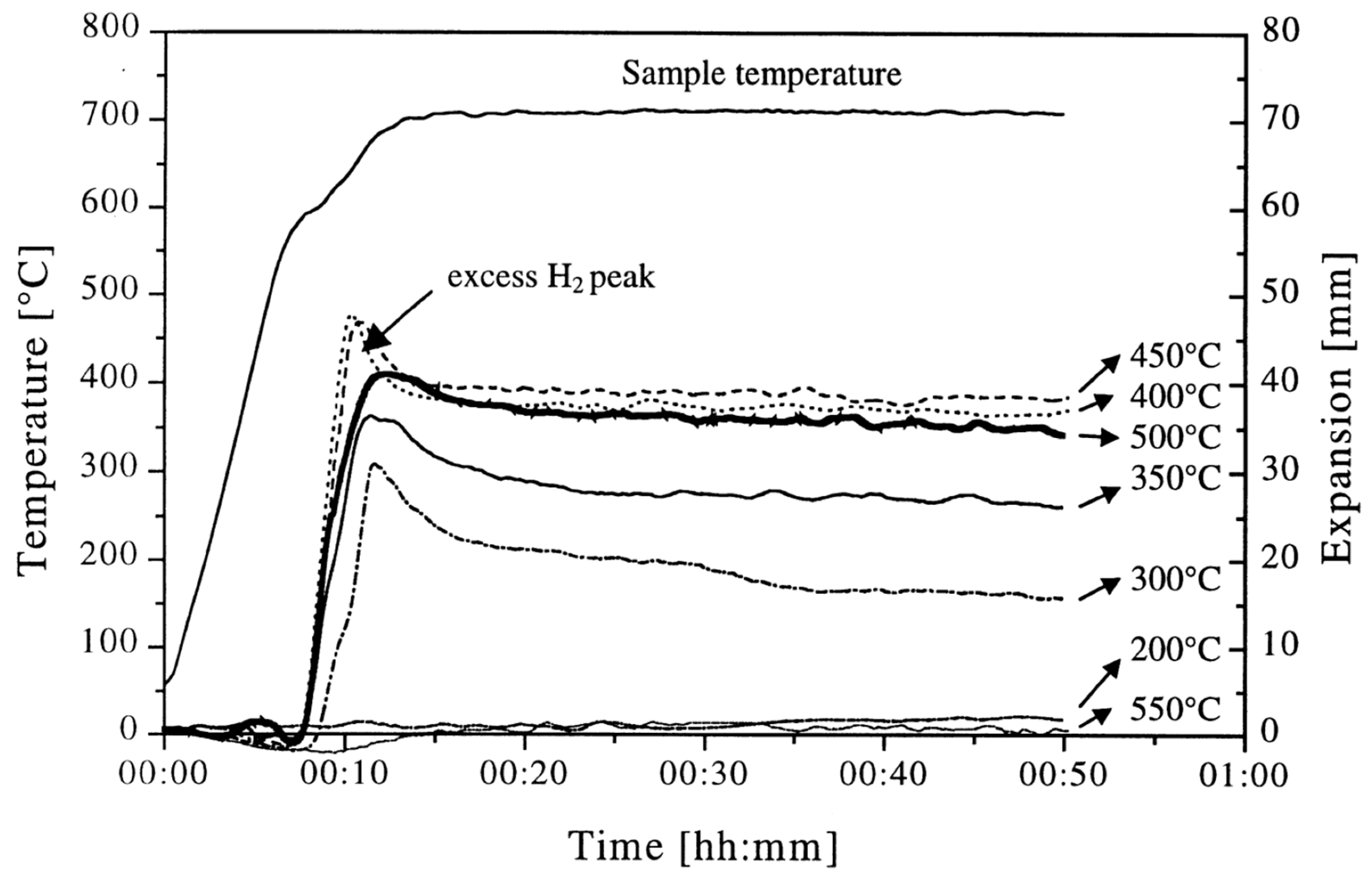
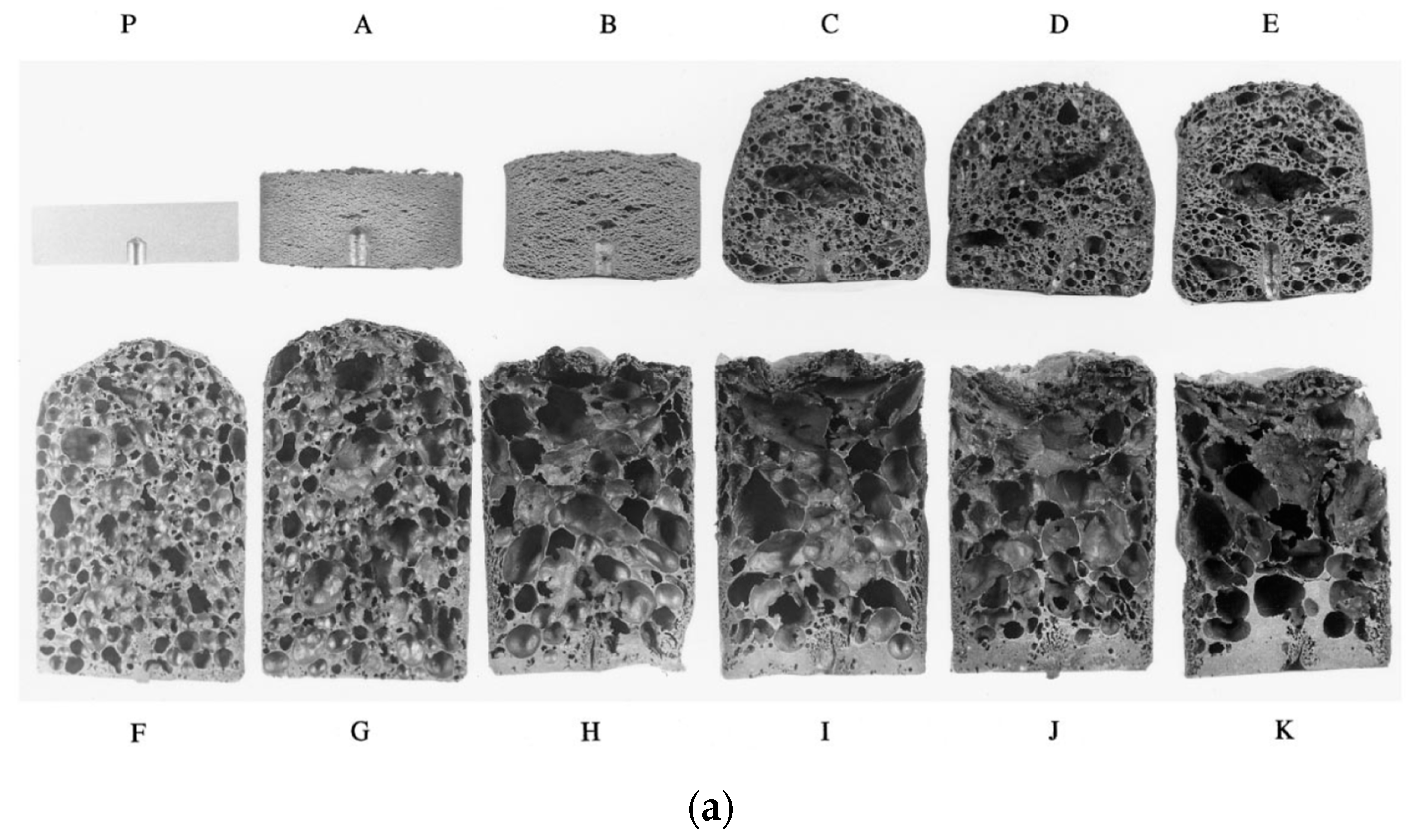
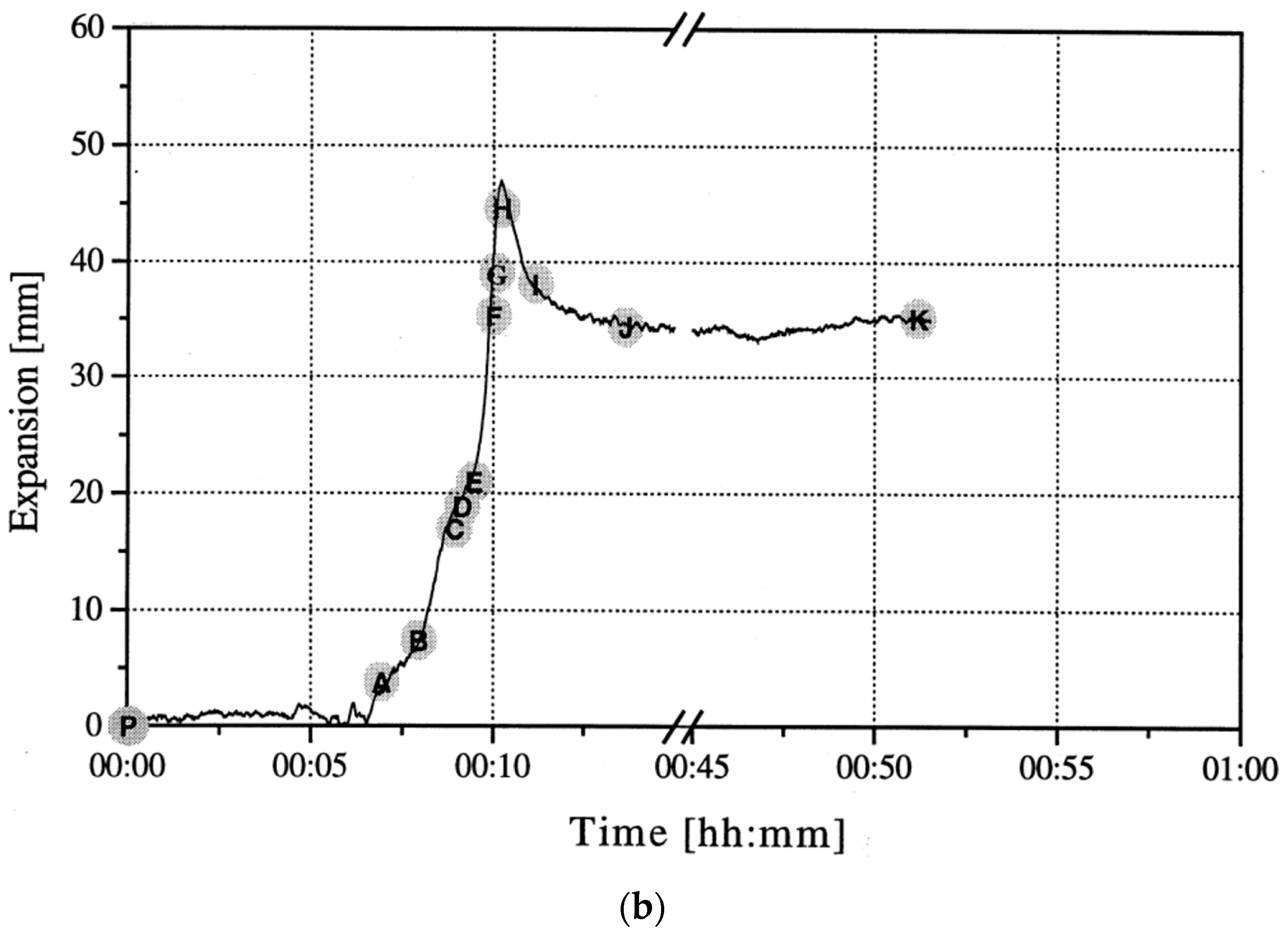
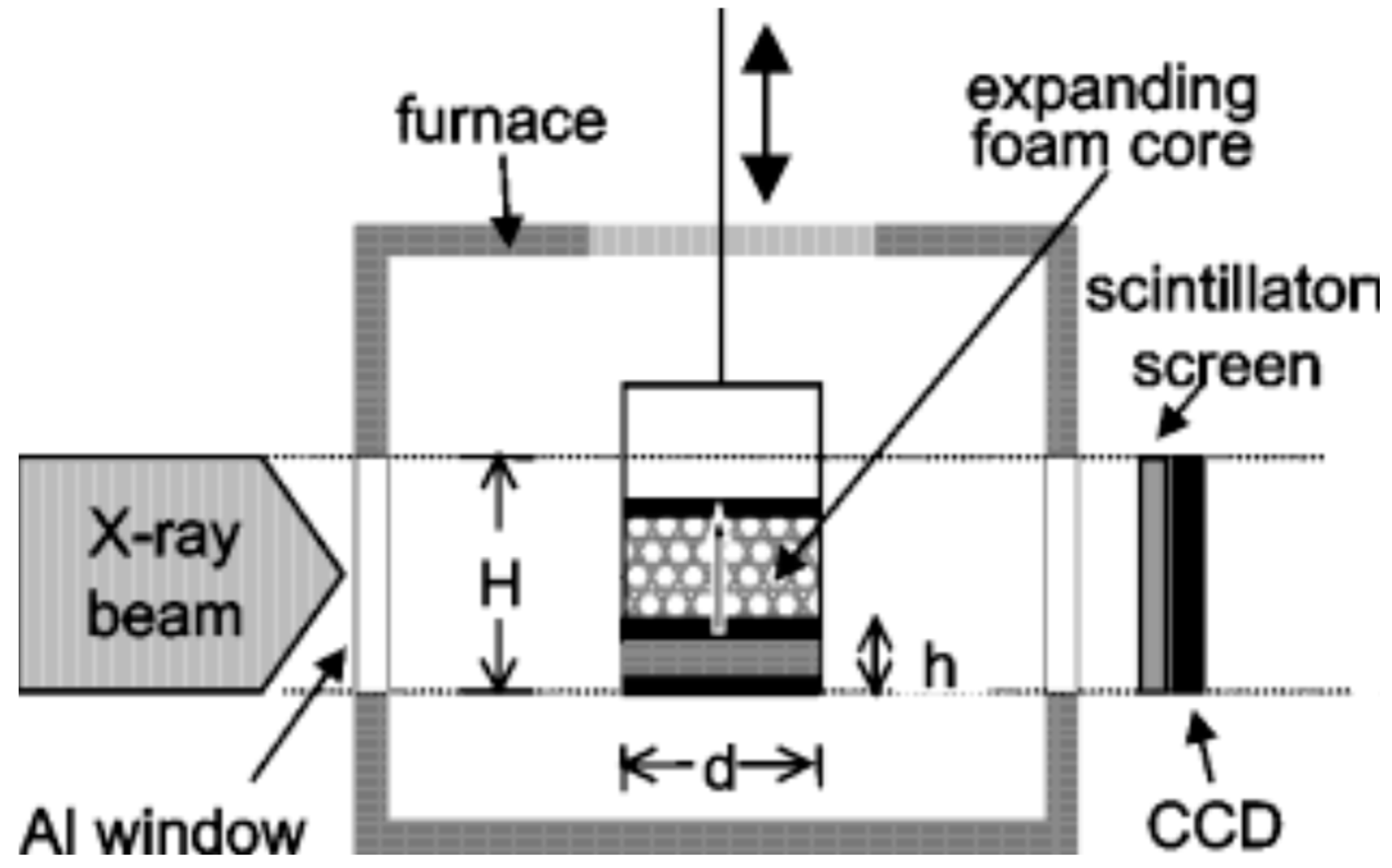
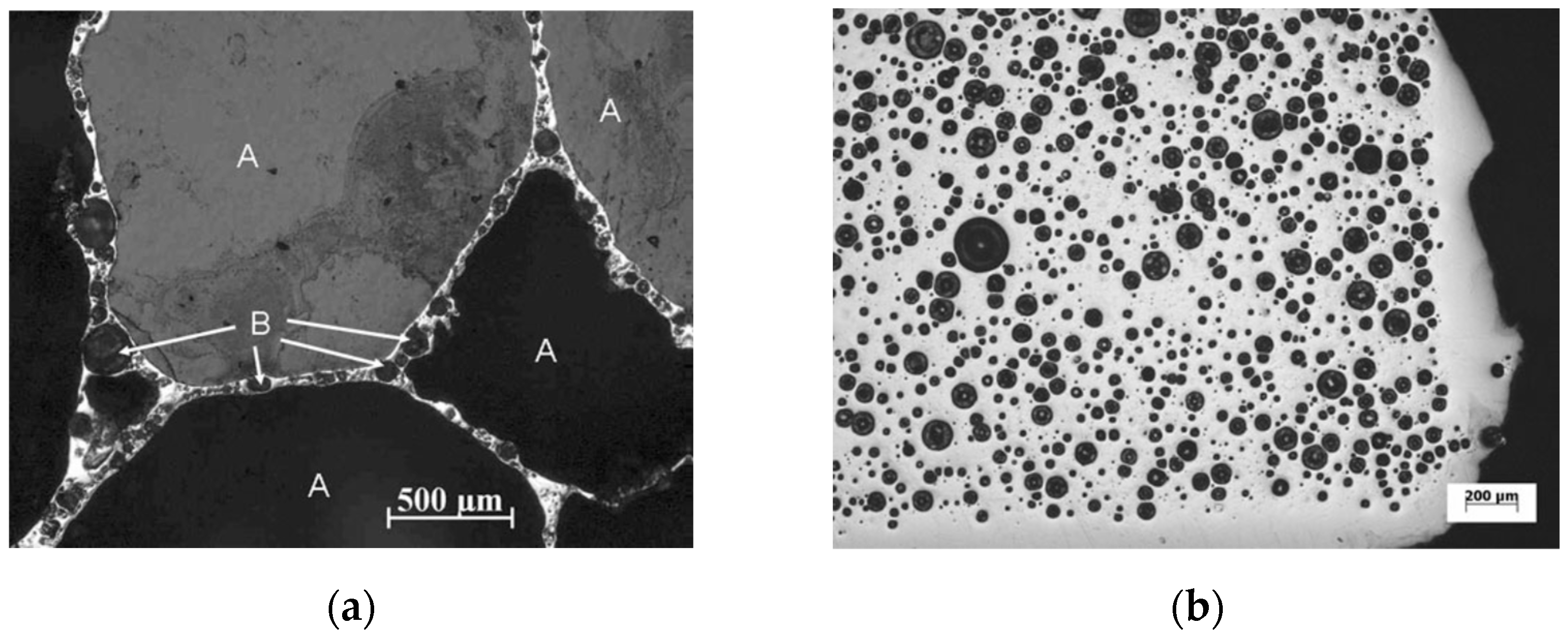

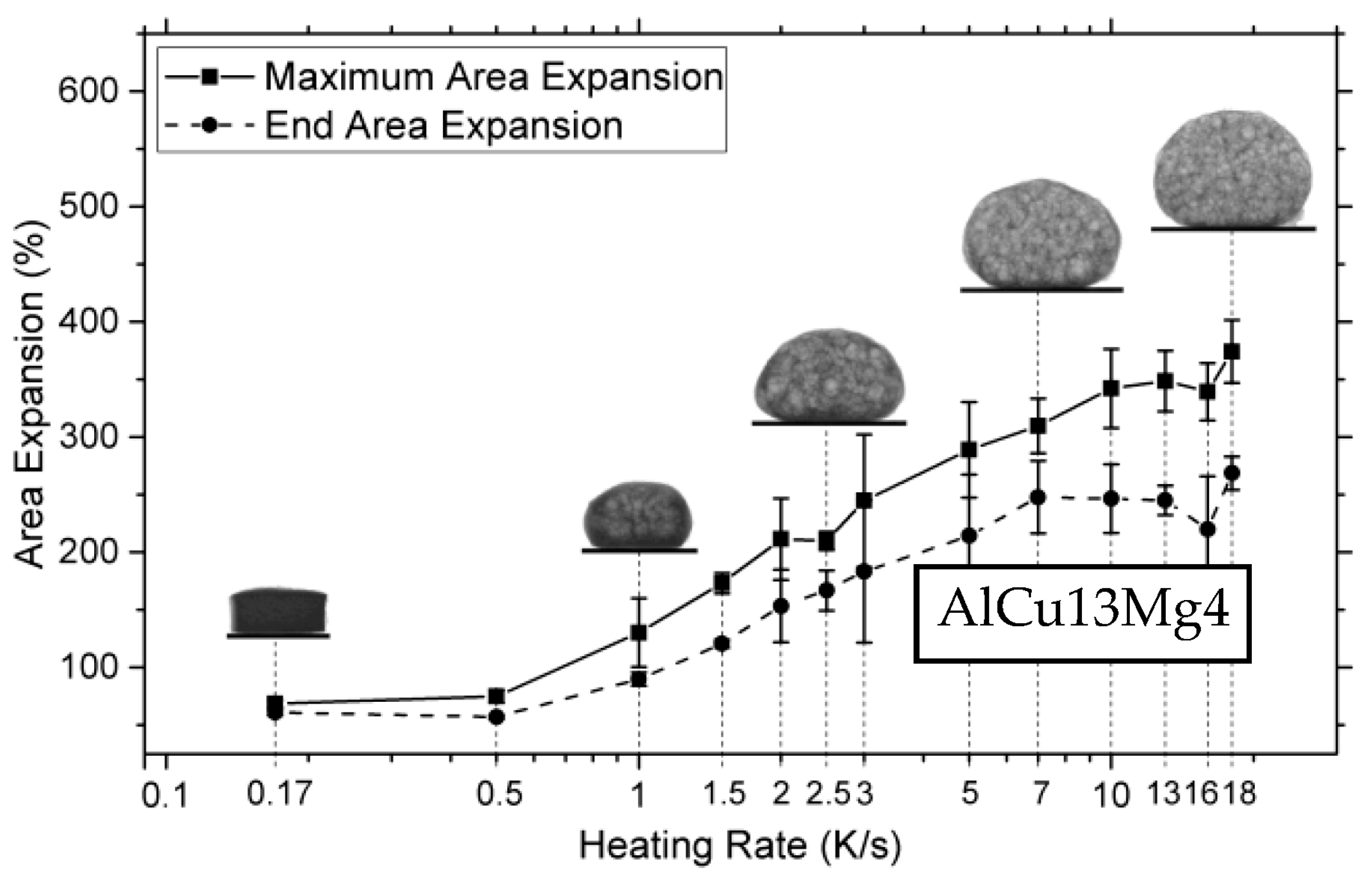
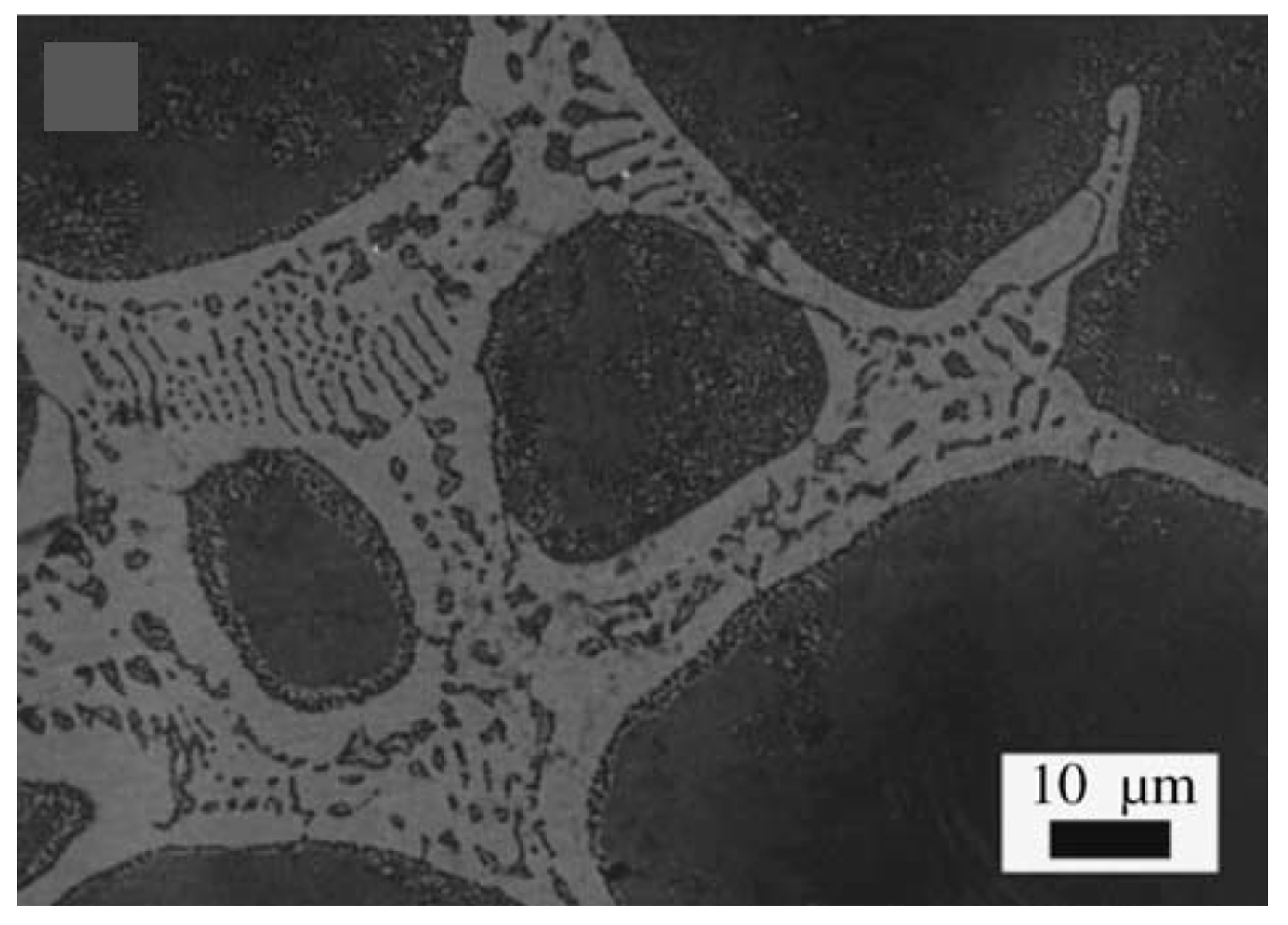
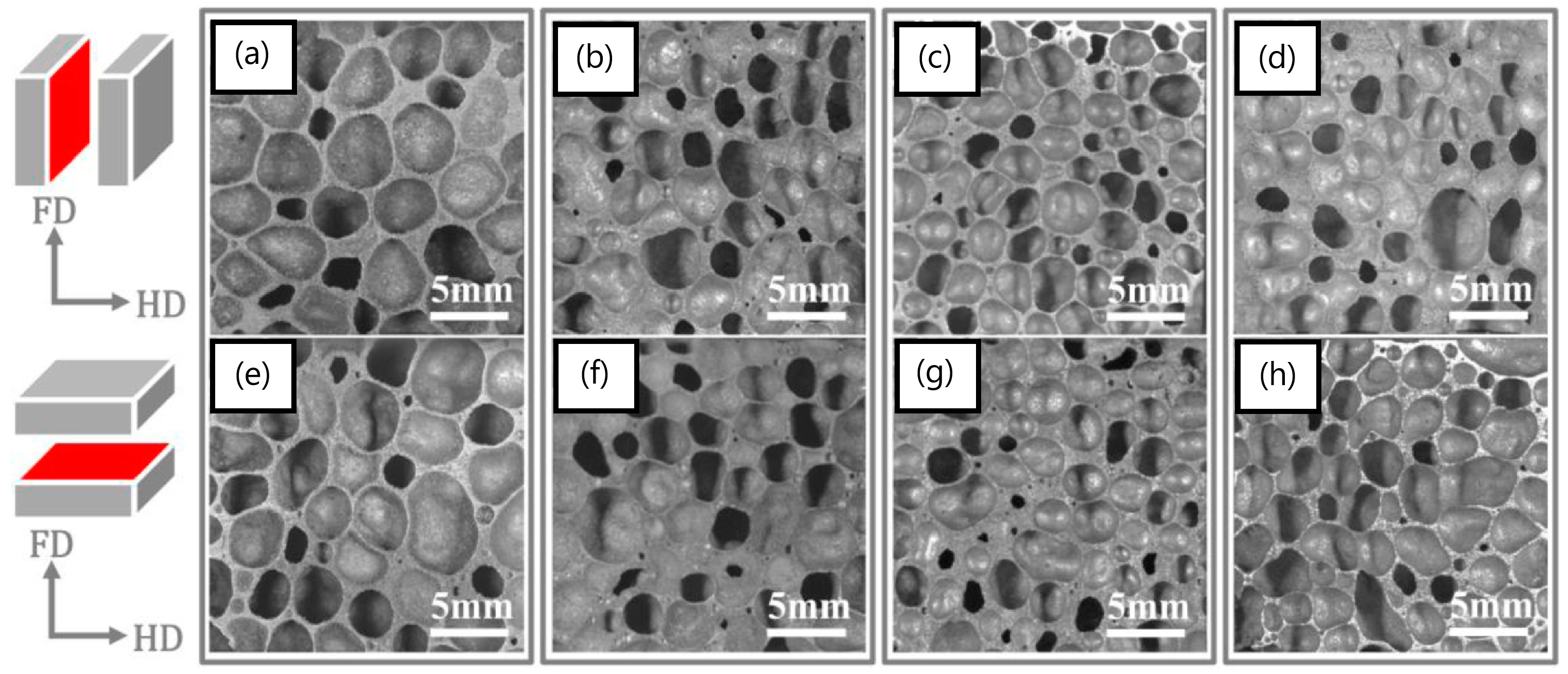
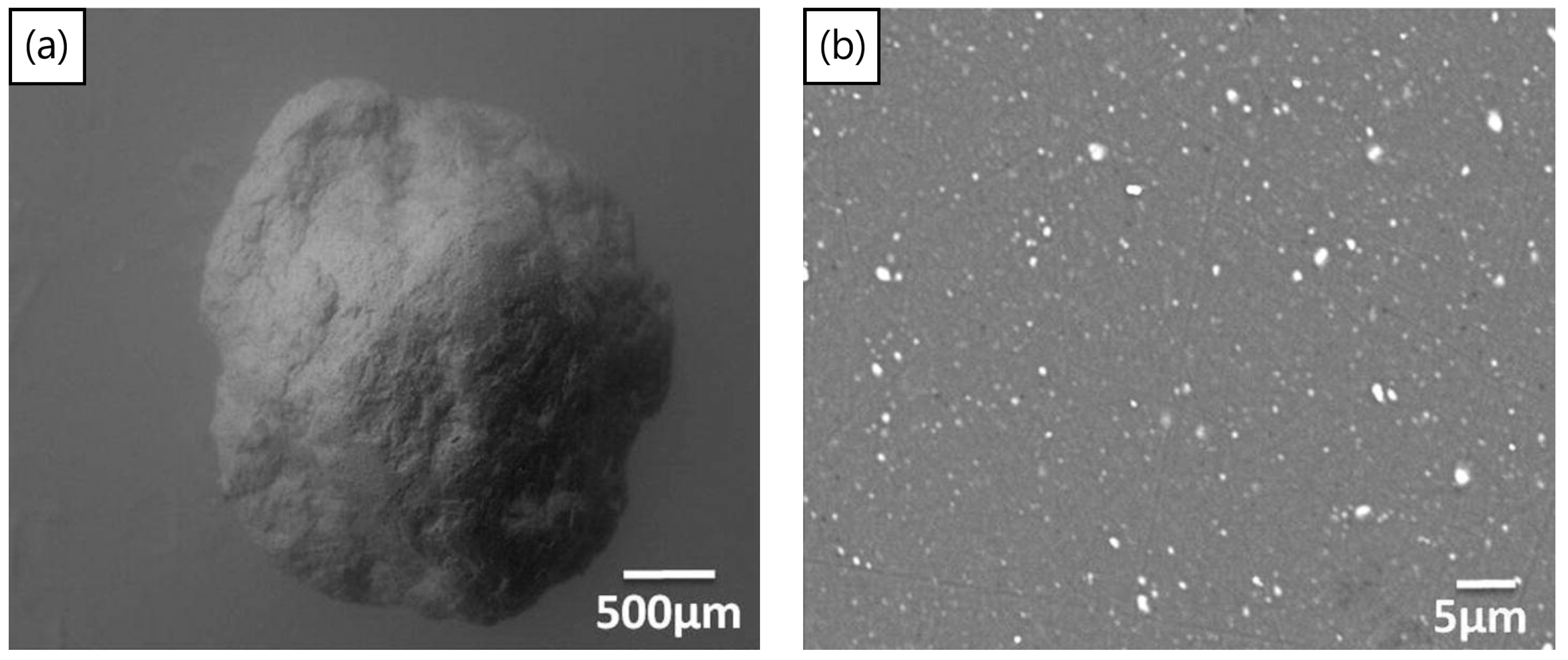

| Blowing Agent | Particle Size (µm) | Gas Release Onset Temperature (°C) |
|---|---|---|
| TiH2 | 1.8 | 420 [45] |
| TiH2 | ~60 | 470 [45] |
| TiH2 * | <63 | 595 [42] |
| ZrH2 | <45 | 205 [27] |
| MgH2 | - | 287 [54,55] |
| NaBH4 | 130 | ~50 [56] |
| LiBH4 | 70 | ~50 [56] |
| LiAlH4 | 30 | ~50 [56] |
| KBH4 | 30 | ~150 [56] |
| AlMg50 ** | - | 330 [57] |
| CaCO3 | 13.5 | 720 [58] |
| CaCO3 | 20 | 600 [59] |
| CaCO3 | 25 | 590 [60] |
| CaMg(CO3)2 | 3.5 | 740 [58] |
| CaMg(CO3)2 | 44 | 650 [61] |
| MgCO3 | 11 | 520 [58] |
| MgCa(CO3)2 | ~46 | 630 [62] |
| Mg(OH)2 | 7.4 | 360 [58] |
| Marble | 106–150 | 660 [60] |
| 4MgCO3∙Mg(OH)2∙5H2O | 11 | 20 (H2O), 340 (CO2) [58] |
| (PbCO3)2∙Pb(OH)2 | - | 140 [39,63] |
| Atmosphere | Gas Release Onset Temperature (°C) | Peak gas Release Temperature (°C) |
|---|---|---|
| Air | ~350 | 655 |
| Helium | ~350 | 620 |
| Vacuum | ~350 | 516 |
Disclaimer/Publisher’s Note: The statements, opinions and data contained in all publications are solely those of the individual author(s) and contributor(s) and not of MDPI and/or the editor(s). MDPI and/or the editor(s) disclaim responsibility for any injury to people or property resulting from any ideas, methods, instructions or products referred to in the content. |
© 2023 by the authors. Licensee MDPI, Basel, Switzerland. This article is an open access article distributed under the terms and conditions of the Creative Commons Attribution (CC BY) license (https://creativecommons.org/licenses/by/4.0/).
Share and Cite
Behymer, N.; Morsi, K. Review: Closed-Cell Metallic Foams Produced via Powder Metallurgy. Metals 2023, 13, 959. https://doi.org/10.3390/met13050959
Behymer N, Morsi K. Review: Closed-Cell Metallic Foams Produced via Powder Metallurgy. Metals. 2023; 13(5):959. https://doi.org/10.3390/met13050959
Chicago/Turabian StyleBehymer, Nathan, and K. Morsi. 2023. "Review: Closed-Cell Metallic Foams Produced via Powder Metallurgy" Metals 13, no. 5: 959. https://doi.org/10.3390/met13050959
APA StyleBehymer, N., & Morsi, K. (2023). Review: Closed-Cell Metallic Foams Produced via Powder Metallurgy. Metals, 13(5), 959. https://doi.org/10.3390/met13050959






